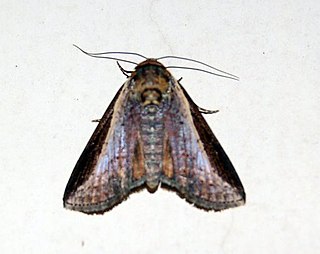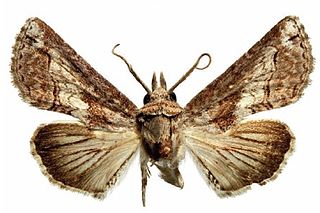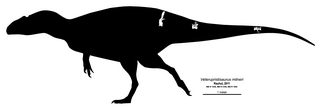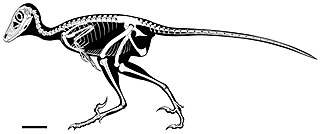Related Research Articles

A holotype is a single physical example of an organism, known to have been used when the species was formally described. It is either the single such physical example or one of several examples, but explicitly designated as the holotype. Under the International Code of Zoological Nomenclature (ICZN), a holotype is one of several kinds of name-bearing types. In the International Code of Nomenclature for algae, fungi, and plants (ICN) and ICZN, the definitions of types are similar in intent but not identical in terminology or underlying concept.

In biology, a type is a particular specimen of an organism to which the scientific name of that organism is formally associated. In other words, a type is an example that serves to anchor or centralizes the defining features of that particular taxon. In older usage, a type was a taxon rather than a specimen.

Algoasaurus is a genus of sauropod dinosaur from the Berriasian-early Valanginian-age Early Cretaceous Upper Kirkwood Formation of Cape Province, South Africa, specifically near a town called Despatch.

Huaxiagnathus is a genus of theropod dinosaur from the Lower Cretaceous of China. It was a compsognathid, large for that group at about half a meter longer than Compsognathus and larger specimens of Sinosauropteryx, with the largest specimen about 1.8 meters in length.

In zoology and botany, a paratype is a specimen of an organism that helps define what the scientific name of a species and other taxon actually represents, but it is not the holotype. Often there is more than one paratype. Paratypes are usually held in museum research collections.

Lophoptera squammigera is a member of the moth family Euteliidae. It occurs in the Oriental tropics from Sri Lanka to Sundaland, Sulawesi, Timor and the Bismarck Archipelago.

Lophoptera is a genus of moths of the family Euteliidae.

Euteliidae is a family of moths in the superfamily Noctuoidea. The family was erected by Augustus Radcliffe Grote in 1882.

Veterupristisaurus is an extinct genus of carcharodontosaurid theropod dinosaur known from the Jurassic of Tendaguru, Lindi Region of southeastern Tanzania.

Lophoptera longipennis is a moth of the family Euteliidae first described by Frederic Moore in 1882. It is found in the India's north-eastern Himalayas, Taiwan, Sumatra, Java and Borneo.

Lophoptera litigiosa is a member of the moth family Euteliidae.
Garudinia triangulata is a moth of the family Erebidae first described by Jeremy Daniel Holloway in 2001. It is found on Borneo. The habitat consists of lowland dipterocarp forests and from lower montane forests.
Chrysomesia lophoptera is a moth of the family Erebidae first described by Alfred Jefferis Turner in 1940. It is found in Queensland, Australia.

Tetradia is a monotypic beetle genus in the family Cerambycidae described by Thomson in 1864. Its only species, Tetradia lophoptera, was described by Félix Édouard Guérin-Méneville in 1844.
Ophyx triangulata is a moth of the family Erebidae. It is found in Indonesia (Batchian).

Monochamus spectabilis is a species of beetle in the family Cerambycidae. It was described by Perroud in 1855, originally under the genus Lophoptera. It has a wide distribution throughout Africa. It contains the varietas Monochamus spectabilis var. immaculipennis.
Caripeta triangulata is a species of moth in the family Geometridae first described by William Barnes and James Halliday McDunnough in 1916. It is found in Central and North America.

Aratasaurus is a monotypic genus of basal coelurosaurian theropod which includes a single species, Aratasaurus museunacionali, known from fossils found in deposits of the Romualdo Formation in Brazil. Aratasaurus lived during the Albian stage of the Early Cretaceous.

Hamititan is a genus of titanosaur sauropod dinosaur from the Shengjinkou Formation of Xinjiang, China. It contains one species, the type species, Hamititan xinjiangensis.

Daurlong is an extinct genus of dromaeosaurid dinosaur from the Early Cretaceous (Aptian) Longjiang Formation of China. The genus contains a single species, D. wangi, known from a nearly complete skeleton. Daurlong represents the first described occurrence of a preserved intestinal region in a theropod closely related to birds.
References
- ↑ "Lophoptera triangulata". InsectIn.com. Archived from the original on March 4, 2016.